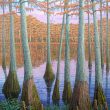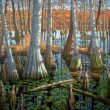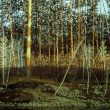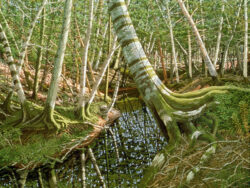Bill Iles
Bill Iles is an accomplished Louisiana painter whose subject matter ranges from almost totally abstract images to landscapes that reflect more his imagination than reality.

Courtesy of Bill Iles
West Fork. Iles, Bill (artist)
Artist Bill Iles is an accomplished painter who taught art at McNeese State University in Lake Charles, Louisiana, for more than twenty-five years. He initially studied history and social studies as an undergraduate at McNeese, but he soon learned he “was better at drawing than remembering dates for the Battle of Hastings.” Born on October 27, 1943, in Dry Creek, Louisiana, Iles credits his father, a bus driver and farmer, for his drawing talents.
During the Vietnam War, the young Iles opted out of military service to teach elementary school at Standing Rock Indian Reservation in South Dakota. He later moved to teach high school in Shreveport and then at Louisiana College in Pineville. In the mid-1970s, he received his master of fine arts at Louisiana Tech in Ruston and in 1978 joined the McNeese faculty, where he served as head of the visual art department and launched the university’s first permanent gallery.
For more than thirty years, Iles has enjoyed considerable success with his paintings, garnering an impressive array of shows across the United States. He has continually experimented with subject matter, ranging from almost totally abstract images to landscapes that reflect more his imagination than reality. “My world revolves around my art,” he said. “I’ve never simply painted what people like.”
Iles’ landscapes are not literal. His paintings of woodlands, a common theme for the artist, are the result of pure imagination given form. “The composition is made up in my head as I work,” he said. “I’m constantly making changes as I go along.” Though he takes photographs of visual elements he finds in during nature walks for later use in the studio, his paintings are more impressions than reality, allegories of his own personal journey.
Iles deploys light and shadows and contrasting colors, textures, and paint strokes to create visual tensions that force viewers’ eyes deep into his imaginary forests. “I don’t paint what you see in nature because nature is too confusing,” he explains. “I’m trying to present some underlying sense of order to a world of disorder. There’s an abstract quality. Nature is not as well ordered as I paint it. I try to give it some clarity.”
Iles prefers to paint autumn scenes because, as he says, Louisiana is a monochromatic green during summer months. “You can’t see the trees for the forest,” he said. He confines his work to southwest Louisiana, but “we’re stuck with a flat landscape,” he said. To compensate for that limitation, he experiments with colors, perspective, and abstraction. “I don’t want my paintings to be picturesque. I want them to feel like paintings. I don’t want my Aunt Martha to say, ‘Oh, what a pretty picture.’ I want viewers to find them perplexingly interesting.”
“As I’m working on my painting I am in touch with a lifetime of memories of the woods as a child playing in them, as a young boy taking his little jars of tempera paint and trying to paint the things he saw before him,” Iles said. “Even as an eleventh grader I realized you could not paint everything because the painting made no sense. It just didn’t look like the woods. So, in the studio I find myself and I find myself creating my own version of the world or my idealistic vision of my world.” To remind him of his “idealistic vision,” a quote from a poem by T.S. Eliot, “Exploring the Waste Land,” hangs on his studio wall—“The end of all our exploring will be to arrive where we started and to know the place for the first time.”
Iles has received numerous awards in various juried art shows in Louisiana and Texas. His work can be found in the public collections of the New Orleans Museum of Art; the Ogden Museum of Southern Art in New Orleans; the Arkansas Art Center in Little Rock; the Northwest Art Center in Minot, North Dakota; the Pensacola Museum of Art in Florida; Del Mar College in Corpus Christi, Texas; Auburn University in Auburn, Alabama; the Beaumont Art League in Beaumont, Texas; the Barnwell Art Center in Shreveport; Appalachian State University in Boone, North Carolina; Louisiana State University; and the Tom Peyton Memorial Collection at First Methodist Church in Alexandria.
Please click below to view images
All rights reserved by the artist.
*The Louisiana Endowment for the Humanities has included this work in 64parishes.org for the purposes of criticism, comment, teaching, scholarship, educational research, all other nonprofit educational usages under Section 107 of the U.S. Copyright Act







